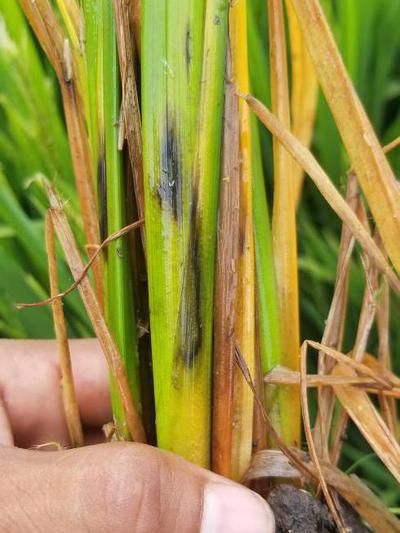Stem Rot of Rice
Magnaporthe salvinii
Fungus
In a Nutshell
- Small, irregular black lesions on leaf sheaths at the water line.
- Stem parts in between leaves rot and collapse.
- Reduced panicle size and chalky grains.
Can also be found in
Symptoms
Symptoms are usually seen after the tillering stage. Initial symptoms are small, irregular black lesions on the outer leaf sheath near water level. As the disease advances, the lesion enlarges, penetrating the inner leaf sheath and culm and producing brownish-black lesions. One or two internodes of the stem eventually rot and collapse (only the epidermis remains intact), leading to lodging, unfilled panicles, chalky grains or death of the tiller. Dark-greyish mycelium can be seen inside hollow, infected stems, with small, black sclerotia dotted over the inner surface.
Recommendations

Organic Control
Methods to control stem rot include good field management practices, and the use of antagonistic organisms.

Chemical Control
Always consider an integrated approach with preventive measures together with biological treatments if available. Spray chemicals based on validamycin or hexaconazole (2 ml/l), propiconazole (1 ml/l) or thiophanate methyl (1.0 g/l) twice at 15 day intervals, usually from the mid-tillering stage, or at the time of disease initiation.
What caused it?
Damage is caused by the fungus Magnaporthe salvinii. It overwinters inside the dead plant tissue, or within the soil. Later on, when the conditions are favorable (high moisture, high nitrogen fertilization), its spores are dispersed through rain splashes and water irrigation. When it lands on a leaf, it sticks to its surface and generates a germ tube that borrows through the leaf cuticle. This process is facilitated on plants with wounds as a result of wrong practices or insect attack. Disease intensity increases as the crop approaches maturity. In the tropics, periods of high moisture after harvest favor the life cycle of the fungus.
Preventive Measures
- Use resistant variables.
- Reduce plant density at planting.
- Reduce nitrogen content and perform split applications.
- Increase the content of potash to keep soil pH high.
- Control weeds in and around the fields.
- Burn any crop residue after harvest and do not let the straw decompose.
- Alternatively, cut rice at ground level and remove the straw from the field in after harvest.
- Another option is to plow residues deep in the soil.
- Avoid stagnation of irrigation water.
- Leave fields fallow for some months or even a year.



